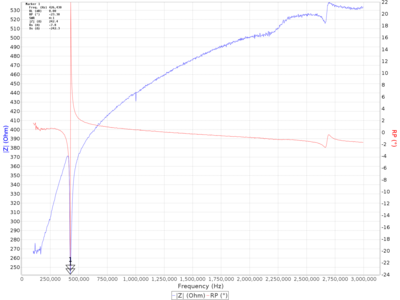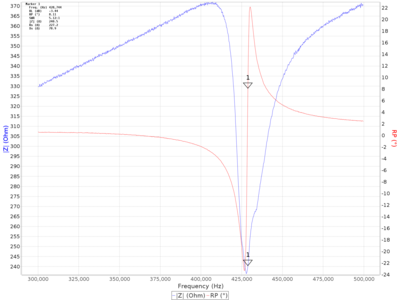Back in the other thread, I mentioned that with what I think the capacity is, and with the inductance measurments with the MFJ meter on both inductors, the big original 5mH one ought to resonate around 250khz or thereabouts. Was I ever wrong (again) - try around 426khz, but wait, there's more - see bump way up there. For giggles, I mounted it back up as if to use it (but not power supply on the input) with no gas present and ran the VNA over it, getting these two interesting plots...nowhere near 250k.

- From the miniVNA pro wide sweep
It's kind of interesting, and from my POV, quite a coincidence that that other bump is where I happen to be working now. This is the first I've seen of it with this inductor. I saw, and proved out for myself, some interesting work on the sort-of spiral antenna effect when you have 1/4 wave of wire in a coil and so on (and I think I put the paper up here somewhere, or can find it again), but despite this being a zillion turns of wire, it's gotta be no where near 1/4 wave of 2.7 or so mhz?
Now I'm going to have to count it (or at least TPI and do an estimate of wire length).
On a narrower sweep it looks like this:

- Narrow sweep, otherwise the same conditions
The marker here is 428khz or so - it's hard to hit on the head.
This is all looking into the power supply end of the inductor, being series resonant with the capacity of the tank and feedthrough.
One issue I have is that under no or light load conditions, the circulating current makes even my 115uH inductor - wound on pyrex of #16 wire - hot enough to smoke. This little stuff wouldn't last a couple seconds with real drive...hmmm. Under load (like when there's a lot of gas lit off by the RF alone and it's a near-short), no problems. However, that appears not to be a useful mode for making fusion. We need volts for that.
I note that with a different driver arrangement and (I'll have to go check this number) 66 or 76 khz. is where I saw some bunching, and I'll have to go and watch my own video about all that to verify the conditions then. That is, FWIW, a big reason for this board and my youtube channel. I try lots of stuff. I forget...while I do backups, sometimes things crash in hard to recover ways...
And that's the theory behind this thread, or part of it - lets do some more backup and condense the info and discussion that's actually meaningful to the search here.
As an aside - in the other measurements up around 2.6 mhz - the lower the gas pressure the more delay shown between the main grid signal (my HV probe) and the faraday probes, which are basically just feedthroughs terminating in a little wire inside the tank. Less gas, more delay - and it's a strong function with gas pressure, which seems to be a strong function for every other thing. Time to pay more attention to that methinks. When gonzo mode happened, we were down at "barely can do this at all" gas pressure of .016 mbar indicated. Usually that means the little spellman that makes up to 40kv at up to 2.5 ma is current limiting around 15 or 20kv. An unmeasurable (by me) change in gas pressure below that and we're out of business - can't keep it going and have to deal with hysterisis even at 40kv on the ion grid out in the big space (better for Paschen's law) to re-light, then edge down the gas....the voltage curve is very near-vertical there.
I am also thinking at this moment that when we are running in "normal fusor mode" that we actually have very small fraction of the gas ionized, from what I've seen here. When we manage to get the 2.6 mhz AC-only thing lit off - it's far lower impedance than would be indicated by the DC meters - we're seeing 100's of ohms. With just DC (it's lower with ion grid on, other things equal) it's more like 750k ohms. Just an observation. While we get weak rays in the middle of a fog of light in RF drive only, we get only the rays in DC mode in the poisser.
For anyone wondering about that funny glow on the glass (white or blue) in the youtube movies, it appears to be electrons, we tried to measure that with the original pinhole cam and a probe as well. It's a lot of them. In continuous running it will heat that stainless steel screen in front of the glass to orange hot. You're only seeing what made it through a grounded screen....